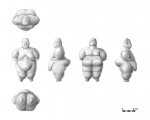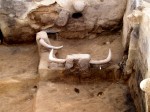 Archaeologists excavating the Neolithic urban settlement of Çatalhöyük in central Turkey have unearthed the figurine of a voluptuous woman in excellent condition. More than 2,000 figurines have been found at Çatalhöyük, but very few of them intact like this one. Several of them were also Mother figures; this is the first one to be found intact and with finely crafted details. It is also unusual in that it was discovered under a platform next to a piece of obsidian where it appears to have been deliberately placed likely for ritual purposes rather than discarded in garbage pits where archaeologists have found many broken statuettes, mostly made of clay. The beautiful Seated Woman of Çatalhöyük, for example, who is herself a zaftig female archetype seated on a throne and captured in the very act of giving birth, was found missing her head and the right hand rest in the shape of a leopard or panther head.
Archaeologists excavating the Neolithic urban settlement of Çatalhöyük in central Turkey have unearthed the figurine of a voluptuous woman in excellent condition. More than 2,000 figurines have been found at Çatalhöyük, but very few of them intact like this one. Several of them were also Mother figures; this is the first one to be found intact and with finely crafted details. It is also unusual in that it was discovered under a platform next to a piece of obsidian where it appears to have been deliberately placed likely for ritual purposes rather than discarded in garbage pits where archaeologists have found many broken statuettes, mostly made of clay. The beautiful Seated Woman of Çatalhöyük, for example, who is herself a zaftig female archetype seated on a throne and captured in the very act of giving birth, was found missing her head and the right hand rest in the shape of a leopard or panther head.
 The figurine is 17 centimeters (6.7 inches) long, 11 centimeters (4.3 inches) wide and weighs one kilo (2.2 pounds), a large, heavy piece for Çatalhöyük. (The Seated Woman is 12 centimeters high.) Her hands and feet are small, markedly out of proportion to her large breasts, belly and buttocks, and her hands are placed under the breasts. She would not have been able to stand vertically on those small feet. The figurine is made of marble, another rarity, and was shaped by extensive polishing of the stone. Details — slanted eyes, a Modigliani-like flat nose, mouth, navel, etc. — were then incised on the figure.
The figurine is 17 centimeters (6.7 inches) long, 11 centimeters (4.3 inches) wide and weighs one kilo (2.2 pounds), a large, heavy piece for Çatalhöyük. (The Seated Woman is 12 centimeters high.) Her hands and feet are small, markedly out of proportion to her large breasts, belly and buttocks, and her hands are placed under the breasts. She would not have been able to stand vertically on those small feet. The figurine is made of marble, another rarity, and was shaped by extensive polishing of the stone. Details — slanted eyes, a Modigliani-like flat nose, mouth, navel, etc. — were then incised on the figure.
 It dates Neolithic occupation of the site, between 7100 and 6000 B.C., so the figurine is at least 8,000 years old. The exaggerated female features — breasts, hips, thighs — of such figures, carved by people for more 40,000 years, have often been interpreted as mother or fertility goddesses, but recent scholarship suggests some of them may represent venerable high status older ladies of the community.
It dates Neolithic occupation of the site, between 7100 and 6000 B.C., so the figurine is at least 8,000 years old. The exaggerated female features — breasts, hips, thighs — of such figures, carved by people for more 40,000 years, have often been interpreted as mother or fertility goddesses, but recent scholarship suggests some of them may represent venerable high status older ladies of the community.
 Çatalhöyük is a fascinating site, founded in a period of transition between highly mobile hunter-gatherers and settled farming communities. No identifiable public buildings have been found thus far, just domestic structures built so close together than people had to use roofs and ladders to move between them. Residents grew a few different kinds of plants and kept cattle — not domesticated yet, mind you — for milk and meat. Large cattle horns were popular decorative features incorporated into the homes. The dead were buried under the houses; there was no dedicated cemetery or burial ground.
Çatalhöyük is a fascinating site, founded in a period of transition between highly mobile hunter-gatherers and settled farming communities. No identifiable public buildings have been found thus far, just domestic structures built so close together than people had to use roofs and ladders to move between them. Residents grew a few different kinds of plants and kept cattle — not domesticated yet, mind you — for milk and meat. Large cattle horns were popular decorative features incorporated into the homes. The dead were buried under the houses; there was no dedicated cemetery or burial ground.
 The Çatalhöyük Research Project has been excavating the settlement since 1993, combining excavation with in situ conservation and curation of artifacts to ensure the long-term preservation of this extraordinarily signficant site. Full details about the newly discovered figurine will be published in the team’s 2016 Archive Report later this year.
The Çatalhöyük Research Project has been excavating the settlement since 1993, combining excavation with in situ conservation and curation of artifacts to ensure the long-term preservation of this extraordinarily signficant site. Full details about the newly discovered figurine will be published in the team’s 2016 Archive Report later this year.